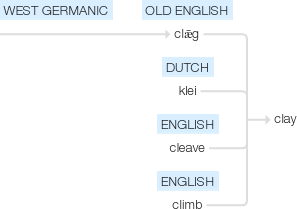Clay
Old English clǣg, of West Germanic origin; related to Dutch klei, also to cleave2 and climb.
wiktionary
From Middle English cley, clay, from Old English clǣġ(“clay”), from Proto-West Germanic *klaij, from Proto-Germanic *klajjaz(“clay”), from Proto-Indo-European *gley-(“to glue, paste, stick together”). [1]
Cognate with Dutch klei(“clay”), Low German Klei(“clay”), German Klei, Danish klæg(“clay”); compare Ancient Greek γλία(glía), Latin glūten(“glue”) (whence ultimately English glue), Ukrainian глина(hlyna, “clay”). Related also to clag, clog.
etymonline
clay (n.)
Old English clæg "stiff, sticky earth; clay," from Proto-Germanic *klaijaz (source also of Old High German kliwa "bran," German Kleie, Old Frisian klai, Old Saxon klei, Middle Dutch clei, Danish klæg "clay;" also Old English clæman, Old Norse kleima, Old High German kleiman "to cover with clay").
Some sources see these as being from a common PIE root meaning "slime; glue" also forming words for "clay" and verbs for "stick together." Compared words include Latin gluten "glue, beeswax;" Greek gloios "sticky matter;" Lithuanian glitus "sticky," glitas "mucus;" Old Church Slavonic glina "clay," glenu "slime, mucus;" Old Irish glenim "I cleave, adhere;" Old English cliða "plaster." But Beekes writes that "Not all comparisons are convincing," and notes that most words cited are from Balto-Slavic or Germanic, "which suggests European substrate origin."
In Scripture, the stuff from which the body of the first man was formed; hence "human body" (especially when dead). As an adjective, "formed of clay," 1520s. Clay-pigeon "saucer of baked clay used as a flying target in trap-shooting," in place of live birds, is from 1881. Feet of clay "fundamental weakness" is from Daniel ii.33.
